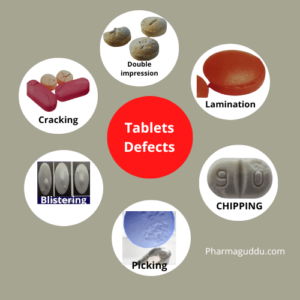What is tablet twinning, and how does it occur during the manufacturing process?

Tablet twinning refers to a manufacturing flaw in which two or more tablets adhere to one another, creating a “twin” or cluster during the coating phase. This issue is particularly prevalent among flat or parallel-faced tablets, primarily due to moisture and pressure during the coating process.
A more comprehensive overview of the causes of tablet twinning includes:
Moisture and Pressure:
During the coating phase, especially when utilizing a sticky coating solution, the combination of moisture and pressure can lead to tablets sticking together.
Tablet Shape:
Tablets with round or oval shapes are more susceptible to twinning compared to other forms, largely because of their flat surfaces.
Pan Speed and Spray Rate:
An imbalance between the pan speed and the spray rate can result in excessive moisture and pressure on the tablets, leading to adhesion.
Insufficient Drying:
Inadequate drying time or conditions can further exacerbate the issue of twinning.
To prevent twinning, consider the following solutions:
Optimize Pan Speed and Spray Rate: Adjust these parameters to achieve a balance that minimizes moisture and pressure on the tablets.
Modify Tablet Shape: If feasible, opt for a tablet design that decreases the flat surface area.
Adjust Coating Formulation: Alter the coating formulation to lessen its stickiness.
Improve Drying Conditions: Ensure that drying conditions are adequate to eliminate excess moisture.
Control Moisture Levels: Lower moisture content in the tablet cores prior to the coating process.
Optimize Lubrication: Ensure that the tablet press and its punches/dies are adequately lubricated.

Tablet TWINNING Defects:
Tablet twinning is a defect that occurs when two tablets, typically formed during the compression process, are fused together. This defect happens when the tablet punches (tools that shape the tablets) press the granulation too hard, causing the powder to flow into adjacent tablets and create a twin or double-shaped tablet.
Causes:
- Excessive Compression Force: When the compression force is too high, it can cause two tablets to stick together.
- Poor Powder Flow: If the powder blend has poor flow properties, it may lead to uneven filling, causing tablets to stick together.
- High Lubricant Levels: Excess lubricant can cause the tablet to stick to the die, leading to twin formation.
- Inconsistent Tablet Shape: If the punches or dies are misaligned, it could result in mis compression, causing tablets to merge.
Solutions:
- Adjust Compression Force: Reducing the compression force ensures that the powder isn’t over-compressed, preventing twin formation.
- Improve Powder Flow: Optimizing the powder’s flowability through proper formulation or using flow aids can help prevent this defect.
- Reduce Lubricant Levels: Reducing the amount of lubricant can minimize the chances of tablets sticking to the die or punch.
- Ensure Proper Punch and Die Alignment: Maintaining proper alignment and ensuring punches are smooth and properly maintained can help avoid the merging of tablets.
Optimize Granulation Process: Proper granulation techniques can improve the tablet’s uniformity and reduce the risk of defects like twinning.
🎓 Discover one of the best Quality assurance courses available — click below to explore the course that’s shaping future QA skills.

